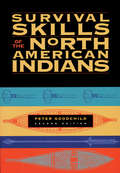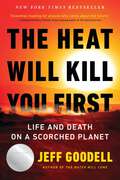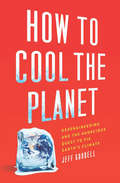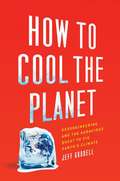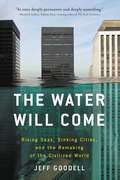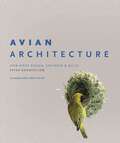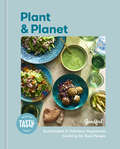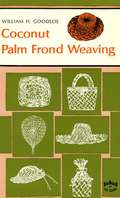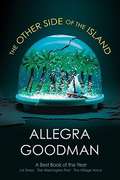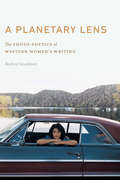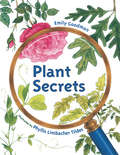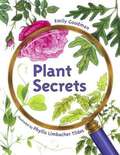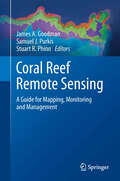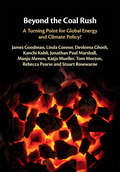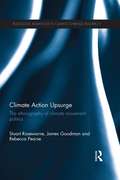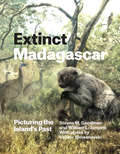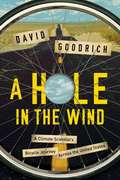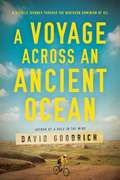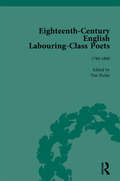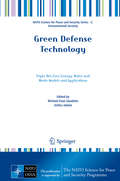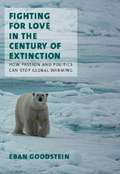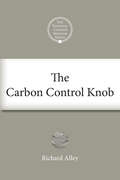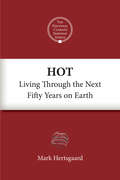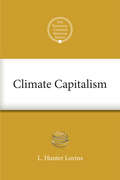- Table View
- List View
Survival Skills of the North American Indians
by Peter GoodchildThis comprehensive review of Native American life skills covers collecting and preparing plant foods and medicines; hunting animals; creating and transporting fire; and crafting tools, shelter, clothing, utensils, and other devices. Step-by-step instructions and 145 detailed diagrams enable the reader to duplicate native methods using materials available in local habitats. A new foreword, introduction, and index complement the practical information offered.
The Heat Will Kill You First: Life and Death on a Scorched Planet
by Jeff GoodellINSTANT NEW YORK TIMES BESTSELLER! NATIONAL BESTSELLER Most Anticipated Book by The New York Times, The Washington Post, The Los Angeles Times • A Next Big Idea Book Club Selection • The New York Times Book Review Editor's Choice • NPR Favorite Books of the Year • Los Angeles Times Best Books of the Year • The Economist Best Books of the YearJeff Goodell's "masterful, bracing" (David Wallace-Wells) investigation exposes "through stellar reporting, artful storytelling and fascinating scientific explanations" (Naomi Klein) an explosive new understanding of heat and the impact that rising temperatures will have on our lives and on our planet. "Entertaining and thoroughly researched," (Al Gore), it will completely change the way you see the world, and despite its urgent themes, is injected with "eternal optimism" (Michael Mann) on how to combat one of the most important issues of our time. &“When heat comes, it&’s invisible. It doesn&’t bend tree branches or blow hair across your face to let you know it&’s arrived…. The sun feels like the barrel of a gun pointed at you.&” The world is waking up to a new reality: wildfires are now seasonal in California, the Northeast is getting less and less snow each winter, and the ice sheets in the Arctic and Antarctica are melting fast. Heat is the first order threat that drives all other impacts of the climate crisis. And as the temperature rises, it is revealing fault lines in our governments, our politics, our economy, and our values. The basic science is not complicated: Stop burning fossil fuels tomorrow, and the global temperature will stop rising tomorrow. Stop burning fossil fuels in 50 years, and the temperature will keep rising for 50 years, making parts of our planet virtually uninhabitable. It&’s up to us. The hotter it gets, the deeper and wider our fault lines will open. The Heat Will Kill You First is about the extreme ways in which our planet is already changing. It is about why spring is coming a few weeks earlier and fall is coming a few weeks later and the impact that will have on everything from our food supply to disease outbreaks. It is about what will happen to our lives and our communities when typical summer days in Chicago or Boston go from 90° F to 110°F. A heatwave, Goodell explains, is a predatory event— one that culls out the most vulnerable people. But that is changing. As heatwaves become more intense and more common, they will become more democratic. As an award-winning journalist who has been at the forefront of environmental journalism for decades, Goodell&’s new book may be his most provocative yet, explaining how extreme heat will dramatically change the world as we know it. Masterfully reported, mixing the latest scientific insight with on-the-ground storytelling, Jeff Goodell tackles the big questions and uncovers how extreme heat is a force beyond anything we have reckoned with before.
How to Cool the Planet
by Jeff GoodellRight now, a group of scientists is working on ways to minimize the catastrophic impact of global warming. But they're not designing hybrids or fuel cells or wind turbines. They're trying to lower the temperature of the entire planet. And they're doing it with huge contraptions that suck CO2 from the air, machines that brighten clouds and deflect sunlight away from the earth, even artificial volcanoes that spray heat-reflecting particles into the atmosphere. This is the radical and controversial world of geoengineering, which only five years ago was considered to be "fringe." But as Jeff Goodell points out, the economic crisis, combined with global political realities, is making these ideas look sane, even inspired. Goodell himself started out as a skeptic, concerned about tinkering with the planet's thermostat. We can't even predict next week's weather, so how are we going to change the temperature of whole regions? What if a wealthy entrepreneur shoots particles into the stratosphere on his own? Who gets blamed if something goes terribly wrong? And perhaps most disturbing, what about wars waged with climate control as the primary weapon? There are certainly risks, but Goodell believes the alternatives could be worse. In the end, he persuades us that geoengineering may just be our last best hope--a Plan B for the environment. His compelling tale of scientific hubris and technical daring is sure to jump-start the next big debate about the future of life on earth.
How to Cool the Planet: Geoengineering and the Audacious Quest to Fix Earth's Climate
by Jeff GoodellWhen Jeff Goodell first encountered the term "geoengineering," he had a vague sense that it involved outlandish schemes to counteract global warming. As a journalist, he was deeply skeptical. But he was also intrigued. The planet was in trouble. Could geoengineers help? Climate change may well be the biggest crisis humanity has ever faced. Temperatures in some regions of the world could increase by as much as fifteen degrees by the end of the century, causing rising sea levels and severe droughts. But change could also happen much more suddenly. What if we had a real climate emergency, the ecological equivalent of the subprime mortgage meltdown -- how could we cool the planet in a hurry? As Goodell shows in this bracing book, even if we could muster the political will for it, cutting greenhouse gas emissions alone may not be enough to reduce the risk of climate catastrophe. This has led some scientists to pursue extreme solutions: huge contraptions that would suck CO2 from the air, machines that would brighten clouds and deflect sunlight away from the earth, even artificial volcanoes that would spray heat-reflecting particles into the atmosphere. In How to Cool the Planet, Goodell explores the scientific, political, financial, and moral aspects of geoengineering. How are we to change the temperature of whole regions if we can't even predict next week's weather? What if a wealthy entrepreneur shoots particles into the stratosphere on his own? What about wars waged with climate control as the primary weapon? What happens to our relationship with nature when, as Goodell puts it, we all find ourselves living in a giant terrarium? And our options are dwindling. Maybe, Goodell suggests, we need to start taking geoengineering seriously. Maybe it's Plan B for the planet. And if it is, we need to know enough to get it right. Thoroughly reported and convincingly argued, How to Cool the Planet is a compelling tale of scientific hubris and technical daring. But it is also a thoughtful, even-handed look at a deeply complex and controversial issue. It's a book that will surely jump-start the next big debate about the future of life on earth.
The Water Will Come: Rising Seas, Sinking Cities, And The Remaking Of The Civilized World
by Jeff GoodellAn eye-opening and essential tour of the vanishing world What if Atlantis wasn't a myth, but an early precursor to a new age of great flooding? <P><P>Across the globe, scientists and civilians alike are noticing rapidly rising sea levels, and higher and higher tides pushing more water directly into the places we live, from our most vibrant, historic cities to our last remaining traditional coastal villages. With each crack in the great ice sheets of the Arctic and Antarctica, and each tick upwards of Earth's thermometer, we are moving closer to the brink of broad disaster. <P><P>By century's end, hundreds of millions of people will be retreating from the world's shores as our coasts become inundated and our landscapes transformed. From island nations to the world's major cities, coastal regions will disappear. Engineering projects to hold back the water are bold and may buy some time. <P><P>Yet despite international efforts and tireless research, there is no permanent solution-no barriers to erect or walls to build-that will protect us in the end from the drowning of the world as we know it. <P><P>The Water Will Come is the definitive account of the coming water, why and how this will happen, and what it will all mean. As he travels across twelve countries and reports from the front lines, acclaimed journalist Jeff Goodell employs fact, science, and first-person, on-the-ground journalism to show vivid scenes from what already is becoming a water world.
Avian Architecture: How Birds Design, Engineer, and Build
by Peter GoodfellowAn illustrated guide to how birds design and build their nestsBirds are the most consistently inventive builders, and their nests set the bar for functional design in nature. Avian Architecture describes how birds design, engineer, and build their nests, deconstructing all types of nests found around the world using architectural blueprints and detailed descriptions of the construction processes and engineering techniques birds use. This spectacularly illustrated book features 300 full-color images and more than 35 case studies that profile key species worldwide. Each chapter covers a different type of nest, from tunnel nests and mound nests to floating nests, hanging nests, woven nests, and even multiple-nest avian cities. Other kinds of avian construction—such as bowers and harvest wells—are also featured.Avian Architecture includes intricate step-by-step sequences, visual spreads on nest-building materials and methods, and insightful commentary by a leading expert.Illustrates how birds around the world design, engineer, and build their nestsFeatures architectural blueprints, step-by-step sequences, visual spreads on nest-building materials and methods, and expert commentaryIncludes 300 full-color imagesCovers more than 100 bird species worldwide
Plant and Planet: Sustainable and Delicious Vegetarian Cooking for Real People
by GoodfulSimple steps can make an impact on our planet. From BuzzFeed&’s Goodful, these 75 plant-based recipes plus plenty of low-waste strategies will guide you to a sustainable life you can feel good about.Goodful offers approachable recipes, tips, and guides for everyday life. In Plant and Planet, discover seventy-five plant-based recipes for meal prep, everyday celebrations, and cooking with the seasons, from Zucchini Lasagna Boats and Black Bean & Walnut Quesadillas to Caramelized Banana & Orange Parfaits, along with tons of ways to stock your kitchen, grow your own ingredients, turn your scraps into amazing treats, and more. Beautifully photographed, this cookbook is super practical and impactful, with surprising and easy ways to reduce environmental impact, shopping guides and meal plans, information about repurposing food waste, plus a guide to growing your own ingredients. You will learn how to:• Approach cooking from a seasonal perspective• Minimize packaging while maximizing flavor• Clear out your fridge and freezer to make comforting soups, salads, and other dishesFeaturing contributions from experts DeVonn Francis, Lorena Ramirez, Lauren Singer, Nadiya Hussain, Kelis Rogers, David Zilber, and Ben Flanner, Plant and Planet is filled with tips and quick hits of information about the environmental impact of these recipes--all to deliver a low-stress, high-impact path to a low-waste kitchen.
Coconut Palm Frond Weaving
by William H. Goodloe Ellen GoodloeLearn the art of palm weaving with this fun Hawaiian craft book.Based on years of meticulous study and practice, the book explains in clear, easy-to understand instructions how to obtain and prepare coconut palm fronds suitable for weaving into hats, baskets, epergnes, mats, birds, and various decorations. More than 100 easy-to-follow diagrams and sketches give the reader exact, detailed instructions on weaving procedures, and provide countless ideas to inspire the imagination of the creator. After mastering the basic principles of frond weaving, the reader will be able to duplicate almost any woven object or execute his own designs, whether in coconut palm fronds or with fronds from other types of palm trees and palmettos.The weaving itself takes no unusual physical prowess. In fact, frond weaving is well suited to the needs of both recreational craft and physical therapy programs, as well as the general hobbyist. With a little patience and effort, a novice weaver can acquire the skills of an ancient art which is as uncomplicated as it is beautiful.This economical and delightfully presented volume will be a valued addition to the literature of traditional handicrafts, a book that recreation libraries and all craft enthusiasts will welcome.
The Other Side of the Island
by Allegra GoodmanFrom New York Times bestselling author Allegra Goodman comes a post apocalyptic novel about love, loss, and the power of human choice. Honor and her parents have been reassigned to live on Island 365 in the Tranquil Sea. Life is peaceful there—the color of the sky is regulated by Earth Mother, a corporation that controls New Weather, and it almost never rains. Everyone fits into their rightful and predictable place. . . . Except Honor. She doesn’t fit in, but then she meets Helix, a boy with a big heart and a keen sense for the world around them. Slowly, Honor and Helix begin to uncover a terrible truth about life on the Island: Sooner or later, those who are unpredictable disappear . . . and they don’t ever come back. The Other Side of the Island has been named a Best Book of 2008 by the LA Times, Washington Post, and Village Voice. .
The Other Side of the Island
by Allegra GoodmanEarth Mother is always watching... And one brave girl is about to find out why.
A Planetary Lens: The Photo-Poetics of Western Women's Writing (Postwestern Horizons)
by Audrey GoodmanA Planetary Lens delves into the history of the photo-book, the materiality of the photographic image on the page, and the cultural significance of landscape to reassess the value of print, to locate the sites where stories resonate, and to listen to western women&’s voices. From foundational California photographers Anne Brigman and Alma Lavenson to contemporary Native poets and writers Leslie Marmon Silko and Joy Harjo, women artists have used photographs to generate stories and to map routes across time and place. A Planetary Lens illuminates the richness and theoretical sophistication of such composite texts. Looking beyond the ideologies of wilderness, migration, and progress that have shaped settler and popular conceptions of the region, A Planetary Lens shows how many artists gather and assemble images and texts to reimagine landscape, identity, and history in the U.S. West. Based on extensive research into the production, publication, and circulation of women&’s photo-texts, A Planetary Lens offers a fresh perspective on the entangled and gendered histories of western American photography and literature and new models for envisioning regional relations.
Plant Secrets
by Emily GoodmanYoung scientists will love this nature mystery that reveals the secrets hiding in seeds, plants, flowers, and fruits throughout the life cycle of various flora. Curiosity will bloom in this introduction to botany and primary nature science. Plants come in all shapes and sizes, but they go through the same stages as they grow. Using four common plants, young readers learn about plant structure and life cycle. Simple text and colorful, detailed illustrations show the major phases of plant growth with each stage holding a &“secret&” for curious readers to guess. Back matter offers more information on each plant, as well as greater detail on each stage of growth.
Plant Secrets
by Emily Goodman Phyllis Limbacher TildesPlants come in all shapes and sizes, but they go through the same stages as they grow. Using four common plants, young readers learn about a plant's life cycles.
Coral Reef Remote Sensing: A Guide for Mapping, Monitoring and Management
by James A. Goodman Samuel J. Purkis Stuart R. PhinnRemote sensing stands as the defining technology in our ability to monitor coral reefs, as well as their biophysical properties and associated processes, at regional to global scales. With overwhelming evidence that much of Earth's reefs are in decline, our need for large-scale, repeatable assessments of reefs has never been so great. Fortunately, the last two decades have seen a rapid expansion in the ability for remote sensing to map and monitor the coral reef ecosystem, its overlying water column, and surrounding environment. Remote sensing is now a fundamental tool for the mapping, monitoring and management of coral reef ecosystems. Remote sensing offers repeatable, quantitative assessments of habitat and environmental characteristics over spatially extensive areas. As the multi-disciplinary field of coral reef remote sensing continues to mature, results demonstrate that the techniques and capabilities continue to improve. New developments allow reef assessments and mapping to be performed with higher accuracy, across greater spatial areas, and with greater temporal frequency. The increased level of information that remote sensing now makes available also allows more complex scientific questions to be addressed. As defined for this book, remote sensing includes the vast array of geospatial data collected from land, water, ship, airborne and satellite platforms. The book is organized by technology, including: visible and infrared sensing using photographic, multispectral and hyperspectral instruments; active sensing using light detection and ranging (LiDAR); acoustic sensing using ship, autonomous underwater vehicle (AUV) and in-water platforms; and thermal and radar instruments. Emphasis and Audience This book serves multiple roles. It offers an overview of the current state-of-the-art technologies for reef mapping, provides detailed technical information for coral reef remote sensing specialists, imparts insight on the scientific questions that can be tackled using this technology, and also includes a foundation for those new to reef remote sensing. The individual sections of the book include introductory overviews of four main types of remotely sensed data used to study coral reefs, followed by specific examples demonstrating practical applications of the different technologies being discussed. Guidelines for selecting the most appropriate sensor for particular applications are provided, including an overview of how to utilize remote sensing data as an effective tool in science and management. The text is richly illustrated with examples of each sensing technology applied to a range of scientific, monitoring and management questions in reefs around the world. As such, the book is broadly accessible to a general audience, as well as students, managers, remote sensing specialists and anyone else working with coral reef ecosystems.
Beyond the Coal Rush: A Turning Point for Global Energy and Climate Policy?
by James Goodman Linda Connor Devleena Ghosh Kanchi Kohli Jonathan Paul Marshall Manju Menon Katja Mueller Tom Morton Rebecca Pearse Stuart RosewarneClimate change makes fossil fuels unburnable, yet global coal production has almost doubled over the last 20 years. This book explores how the world can stop mining coal - the most prolific source of greenhouse gas emissions. It documents efforts at halting coal production, focusing specifically on how campaigners are trying to stop coal mining in India, Germany, and Australia. Through in-depth comparative ethnography, it shows how local people are fighting to save their homes, livelihoods, and environments, creating new constituencies and alliances for the transition from fossil fuels. The book relates these struggles to conflicts between global climate policy and the national coal-industrial complex. With coal's meaning transformed from an important asset to a threat, and the coal industry declining, it charts reasons for continuing coal dependence, and how this can be overcome. It will provide a source of inspiration for energy transition for researchers in environment, sustainability, and politics, as well as policymakers.
Climate Action Upsurge: The Ethnography of Climate Movement Politics (Routledge Advances in Climate Change Research)
by James Goodman Rebecca Pearse Stuart RosewarneIn the late 2000s climate action became a defining feature of the international political agenda. Evidence of global warming and accelerating greenhouse gas emissions created a new sense of urgency and, despite consensus on the need for action, the growing failure of international climate policy engendered new political space for social movements. By 2007 a ‘climate justice’ movement was surfacing and developing a strong critique of existing official climate policies and engaging in new forms of direct action to assert the need for reduced extraction and burning of fossil fuels. Climate Action Upsurge offers an insight into this important period in climate movement politics, drawing on the perspectives of activists who were directly engaged in the mobilisation process. Through the interpretation of these perspectives the book illustrates important lessons for the climate movement today. In developing its examination of the climate action upsurge, the book focuses on individual activists involved in direct action ‘Climate Camps’ in Australia, while drawing comparisons and highlighting links with climate campaigns in other locales. The book should be of interest to scholars and researchers in climate change, environmental sociology, politics, policy and activism.
Extinct Madagascar: Picturing the Island's Past
by Steven M. Goodman William L. Jungers Plates by Velizar SimeonovskiThe landscapes of Madagascar have long delighted zoologists, who have discovered, in and among the island s baobab trees and thickets, a dizzying array of animals, including something approaching one hundred species of lemur. Madagascar s mammal fauna, for example, is far more diverse, and more endemic, than early explorers and naturalists ever dreamed of. But in the past 2,500 or so years a period associated with natural climatic shifts and ecological change, as well as partially coinciding with the arrival of the island s first human settlers a considerable proportion of Madagascar s forests have disappeared; and in the wake of this loss, a number of species unique to Madagascar have vanished forever into extinction. In "Extinct Madagascar," noted scientists Steven M. Goodman and William L. Jungers explore the recent past of these land animal extinctions. Beginning with an introduction to the geologic and ecological history of Madagascar that provides context for the evolution, diversification, and, in some cases, rapid decline of the Malagasy fauna, Goodman and Jungers then seek to recapture these extinct mammals in their environs. Aided in their quest by artist Velizar Simeonovski s beautiful and haunting digital paintings images of both individual species and ecosystem assemblages reproduced here in full color Goodman and Jungers reconstruct the lives of these lost animals and trace their relationships to those still living. Published in conjunction with an exhibition of Simeonovski s artwork set to open at the Field Museum, Chicago, in the fall of 2014, Goodman and Jungers s awe-inspiring book will serve not only as a sobering reminder of the very real threat of extinction, but also as a stunning tribute to Madagascar s biodiversity and a catalyst for further research and conservation. "
A Hole in the Wind: A Climate Scientist's Bicycle Journey Across The United States
by David GoodrichAn epic bicycle journey across the American hinterland that explores the challenges of climate change alongside a diverse array of American voices. After a distinguished career in climate science as the Director of the UN Global Climate Observing System in Geneva, David Goodrich returned home to the United States to find a nation and a people in denial. Concerned that the American people are willfully deluded by the misinformation about climate that dominates media and politics, David thought a little straight talk could set things right. As they say in Animal House, he decided that "this calls for a stupid and futile gesture on someone's part, and I'm just the guy to do it." Starting on the beach in Delaware, David rode his bike 4,200 miles to Oregon, talking with the people he met on the ultimate road trip. Along the way he learned a great deal about why climate is a complicated issue for many Americans and even more about the country we all share. Climate change is the central environmental issue of our time. But A Hole in the Wind is also about the people Dave met and the experiences he had along the way, like the toddler's beauty pageant in Delaware, the tornado in Missouri, rust-belt towns and their relationship with fracking, and the mined-out uranium ghost town in Wyoming. As he rides, David will discuss the climate with audiences varying from laboratories to diners to elementary schools. Beautifully simple, direct, and honest, A Hole in the Wind is a fresh, refreshing ride through a difficult and controversial topic, and a rich read that makes you glad to be alive.
A Voyage Across an Ancient Ocean: A Bicycle Journey Through the Northern Dominion of Oil
by David GoodrichIn the face of widespread misinformation and misunderstanding, a climate scientist ventures into the vast heart of America&’s new oil country on just two wheels.Recently recovered from his epic bicycle journey that took him from the Delaware shore to the Oregon coast, distinguished climate scientist David Goodrich sets out on his bike again to traverse the Western Interior Seaway—an ancient ocean that once spread across half of North America. When the waters cleared a geologic age ago, what was left behind was vast, flat prairie, otherworldly rock formations, and oil shale deposits. As Goodrich journeys through the Badlands and Theodore Roosevelt National Park and across the prairies of the upper Midwest and Canada, we get a raw and ground-level view of where the tar sands and oil reserves are being opened up at an incredible and unprecedented pace. Extraordinary and unregulated, this &“black goldrush&” is boom and bust in every sense. In a manner reminiscent of John McPhee and Rachel Carson, combined with Goodrich&’s wry self-deprecation and scientific expertise, A Voyage Across an Ancient Ocean is a galvanizing and adventure-filled read that gets to the heart of drilling on our continent.
Eighteenth-Century English Labouring-Class Poets, vol 3
by John Goodridge Simon Kövesi David Fairer Tim Burke William ChristmasPoets of labouring class origin were published in Britain in the 18th and 19th centuries. Some were popular and important in their day but few are available today. This is a collection of some of those poems from the 18th century.
Green Defense Technology
by Michael Evan Goodsite Sirkku JuholaThis book focuses on the ways in which military installations and small cities can implement and integrate triple net planning and energy, water, and waste sustainability strategies into broad installation operational management, arrive at the best decision, create policy and communicate effectively to stakeholders. It explores current and emerging technologies, methods, and frameworks for energy conservation, efficiency, and renewable energy within the context of triple net zero implementation practice. Recognizing that the challenge extends beyond finding technological solutions to achieve triple net zero outcomes, the contributions also address the need for a systemic view in the planning phase, as well as adequate communication and policy measures and incentives.
Fighting for Love in the Century of Extinction: How Passion and Politics Can Stop Global Warming
by Eban GoodsteinThe central idea in Fighting for Love in the Century of Extinction is simple: Unchecked, global warming threatens to destroy one of every two animals, birds, plants, reptiles, forests, fish and other creatures alive today on the earth. This looming ecological collapse will only be arrested if we can articulate and embrace what the natural world means to each of us, and then fight a series of hard political battles to preserve creation. On a subject about which it is easy to feel despair, Goodstein offers a realistic, ambitious, and hopeful political solution to avoid a century of mass extinction, a vision grounded in a moral view that embraces the interconnection of all life forms on the planet. Emerging from his work as both an economist and a leader in the clean energy movement, this passionate book sets a new frame for helping Americans understand global warming as the challenge of our generation. Weaving personal narrative with scientific facts, Goodstein begins with an overview of the current global warming crisis. In Chapters 2 and 3 ("Wealth" and "Knowledge") he explores the question of whether the scale of mass extinction we are beginning to witness in the 21st century has more ominous implications for human welfare than it did in the 20th century. By destroying so much of creation,will we destroy the foundation of our own material prosperity? By tearing out so many pages in the book of life, are we depriving future generations of a vast store of knowledge? In "Spirit," he stresses the need to re-spiritualize the way we talk about the natural world. Without an effective moral language that reflects our deeply felt love of nature and its diversity, effective political action is impossible. "Politics" argues that if we are to hold global heating to the manageable, low end, Americans must stabilize emissions of global warming pollutants and begin to invest tens of billions of dollars every year in clean-energy technology solutions for the future. Stabilizing the climate requires strong leadership from the federal government --we must elect clean-energy leaders into the Senate, the House, and the Oval Office in the next few years. How to do this, by becoming involved in electoral politics, is the subject of the final chapter, "Solutions."
The Carbon Control Knob
by Eban Goodstein Richard AlleyOn November 2, 2011, Richard Alley participated in The National Climate Seminar, a series of webinars sponsored by Bard College's Center for Environmental Policy. The online seminars provide a forum for leading scientists, writers, and other experts to talk about critical issues regarding climate change. The series also opens a public conversation, inviting participants to ask questions and contribute their own thoughts. Dr. Alley conducts research on the paleoclimatic record at The Pennsylvania State University in order to understand the history, and perhaps the future, of climate change. In his lecture, Alley gave a concise overview of why we know what we know about climate change, and what that evidence can tell us about today's warming planet. Alley not only provides an accessible science lesson, but reveals his own greatest concerns about climate change and offers advice to those who want to stop debating the subtleties of climate science and act now. This E-ssential is an edited version of Alley's talk and the subsequent question and answer session. While some material has been cut and some language modified for clarity, the intention was to retain the substance of the original discussion.
Hot: Living Through the Next Fifty Years on Earth
by Eban Goodstein Mark HertsgaardOn December 7, 2011, Mark Hertsgaard participated in The National Climate Seminar, a series of webinars sponsored by Bard College's Center for Environmental Policy. The online seminars provide a forum for leading scientists, writers, and other experts to talk about critical issues regarding climate change. The series also opens a public conversation, inviting participants to ask questions and contribute their own thoughts. Hertsgaard has spent the last two decades reporting on climate change for media outlets including The New Yorker, NPR, Time, Vanity Fair, and The Nation, where he is the environment correspondent. His lecture focused on political movements and how environmental advocates can provoke change in public attitudes and on Capitol Hill. Hertsgaard sees 2011's Occupy movement as a sign of real hope and discussed what climate activists can learn from Occupy's tactics. This E-ssential is an edited version of Hertsgaard's talk and the subsequent question and answer session. While some material has been cut and some language modified for clarity, the intention was to retain the substance of the original discussion.
Climate Capitalism
by Eban Goodstein L. Hunter LovinsOn October 5, 2011, L. Hunter Lovins participated in The National Climate Seminar, a series of webinars sponsored by Bard College's Center for Environmental Policy. The online seminars provide a forum for leading scientists, writers, and other experts to talk about critical issues regarding climate change. The series also opens a public conversation, inviting participants to ask questions and contribute their own thoughts. Lovins is President and founder of Natural Capitalism Solutions (NCS / www.natcapsolutions.org). NCS works with businesses, governments, and civil society to develop practices that are sustainable for both people and the environment. Her lecture focused on ways that the United States can pull itself out of the current recession, while preserving natural and human capital. This E-ssentialis an edited version of Lovins' talk and the subsequent question and answer session. While some material has been cut and some language modified for clarity, the intention was to retain the substance of the original discussion.
